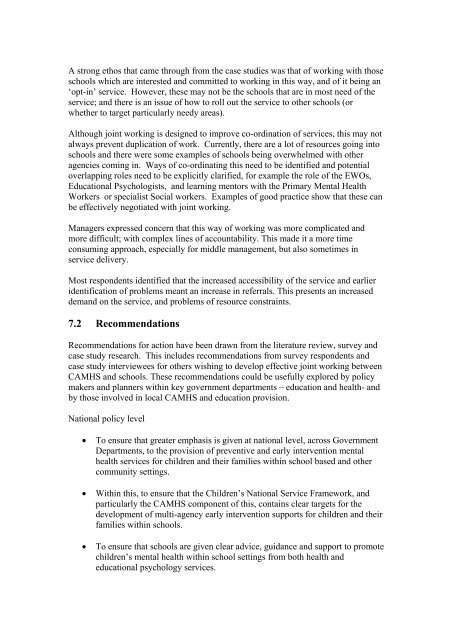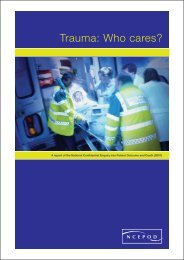(CAMHS) and Schools - London Health Programmes
(CAMHS) and Schools - London Health Programmes
(CAMHS) and Schools - London Health Programmes
You also want an ePaper? Increase the reach of your titles
YUMPU automatically turns print PDFs into web optimized ePapers that Google loves.
A strong ethos that came through from the case studies was that of working with those<br />
schools which are interested <strong>and</strong> committed to working in this way, <strong>and</strong> of it being an<br />
‘opt-in’ service. However, these may not be the schools that are in most need of the<br />
service; <strong>and</strong> there is an issue of how to roll out the service to other schools (or<br />
whether to target particularly needy areas).<br />
Although joint working is designed to improve co-ordination of services, this may not<br />
always prevent duplication of work. Currently, there are a lot of resources going into<br />
schools <strong>and</strong> there were some examples of schools being overwhelmed with other<br />
agencies coming in. Ways of co-ordinating this need to be identified <strong>and</strong> potential<br />
overlapping roles need to be explicitly clarified, for example the role of the EWOs,<br />
Educational Psychologists, <strong>and</strong> learning mentors with the Primary Mental <strong>Health</strong><br />
Workers or specialist Social workers. Examples of good practice show that these can<br />
be effectively negotiated with joint working.<br />
Managers expressed concern that this way of working was more complicated <strong>and</strong><br />
more difficult; with complex lines of accountability. This made it a more time<br />
consuming approach, especially for middle management, but also sometimes in<br />
service delivery.<br />
Most respondents identified that the increased accessibility of the service <strong>and</strong> earlier<br />
identification of problems meant an increase in referrals. This presents an increased<br />
dem<strong>and</strong> on the service, <strong>and</strong> problems of resource constraints.<br />
7.2 Recommendations<br />
Recommendations for action have been drawn from the literature review, survey <strong>and</strong><br />
case study research. This includes recommendations from survey respondents <strong>and</strong><br />
case study interviewees for others wishing to develop effective joint working between<br />
<strong>CAMHS</strong> <strong>and</strong> schools. These recommendations could be usefully explored by policy<br />
makers <strong>and</strong> planners within key government departments – education <strong>and</strong> health- <strong>and</strong><br />
by those involved in local <strong>CAMHS</strong> <strong>and</strong> education provision.<br />
National policy level<br />
• To ensure that greater emphasis is given at national level, across Government<br />
Departments, to the provision of preventive <strong>and</strong> early intervention mental<br />
health services for children <strong>and</strong> their families within school based <strong>and</strong> other<br />
community settings.<br />
• Within this, to ensure that the Children’s National Service Framework, <strong>and</strong><br />
particularly the <strong>CAMHS</strong> component of this, contains clear targets for the<br />
development of multi-agency early intervention supports for children <strong>and</strong> their<br />
families within schools.<br />
• To ensure that schools are given clear advice, guidance <strong>and</strong> support to promote<br />
children’s mental health within school settings from both health <strong>and</strong><br />
educational psychology services.

















